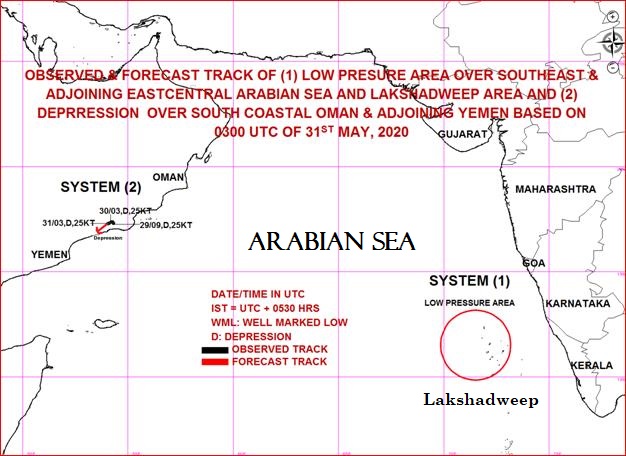Contents
- Assam to provide tap connections to 13 lakh households
- Low Pressure Area over Arabian Sea and Lakshadweep
ASSAM TO PROVIDE TAP CONNECTIONS TO 13 LAKH HOUSEHOLDS
Focus: GS-II Social Justice, Prelims
Why in news?
- Assam presented the Annual Action Plan for consideration and approval of Ministry of Jal Shakti – with plans to immediately provide household tap connections to all remaining households of belonging to weaker and marginalised sections on priority.
- Assam plans to provide tap connections to 13 lakh households out of total 63 lakhs.
Details
- Realization of the goal of Jal Jeevan Mission in Assam is not difficult taking into account the abundant water resources in the State i.e., both ground water and surface water.
- A defined roadmap is also charted for the effective implementation of Village Action Plan (VAP) with the active participation of the rural community. Strengthening of existing drinking water sources for long-term sustainability of drinking water supply systems through convergence of various programmes like MGNREGS.
- Thrust is given on covering households in quality-affected habitations, aspirational districts, SC/ ST dominated villages/ habitations, Sansad Adarsh Gramin Yojana villages, etc. on priority.
Jal Jeevan Mission
- Jal Jeevan Mission (JJM), a central government initiative under the Ministry of Jal Shakti, aims to ensure access of piped water for every household in India.
- National Rural Drinking Water Programme (NRDWP) was restructured and subsumed into Jal Jeevan Mission (JJM) – to provide Functional Household Tap Water (FHTC) to every rural household with service level at the rate of 55 lpcd i.e., Har Ghar Nal Se Jal (HGNSJ) by 2024.
- JJM focuses on integrated demand and supply-side management of water at the local level.
- The Mission is based on a community approach to water and includes extensive Information, Education and Communication as a key component of the mission.
- Creation of local infrastructure for source sustainability measures as mandatory elements, like rainwater harvesting, groundwater recharge and management of household wastewater for reuse, would be undertaken in convergence with other government programmes/schemes.
- The fund sharing pattern between the Centre and states is 90:10 for Himalayan and North-Eastern States, 50:50 for other states, and 100% for Union Territories.
Institutional Arrangement for JJM
- National Jal Jeevan Mission (NJJM) at the Central level
- State Water and Sanitation Mission (SWSM) at the State level
- District Water and Sanitation Mission (DWSM) at the District level
- Village Water Sanitation Committee (VWSC) at Village level
Every village will prepare a Village Action Plan (VAP) which will have three components:
- Water source & its maintenance
- Water supply and
- Greywater (domestic wastewater) management.
Implications
- Supply of water to all households is a basic necessity
- Reduction in water borne diseases which was due to due to consumption of substandard water
Other Expected Outcomes of JJM
- Source sustainability for Jal Jeevan Mission in the project area with active participation of local communities.
- Contribute towards the goal of doubling the farmers’ income.
- Promote participatory ground water management. Improved water use efficiency on a mass scale and improved cropping pattern;
- Promote efficient and equitable use of ground water resources and behavioral change at the community level.
Challenges
- Critical situation of Decrease in ground water table.
- Water demand and supply is a miss match
- Contamination of local ground level sources of water like, ponds lakes and wells.
- Sustaining the provision of water to all households is a challenge, not just starting it.
Way forward
- Integrated water management Programme from school level.
- Jan andolan for Conservation of water,
- Curb ground water and surface water pollution
- Stopping the over exploitation of ground water
- Ground water mapping, using GIS enabled systems, use of ICT to track the availability of water should be done by government.
LOW PRESSURE AREA OVER ARABIAN SEA AND LAKSHADWEEP
Focus: GS-I Geography, Prelims
Why in news?
- A low-pressure area formed over southeast & adjoining east-central Arabian Sea and Lakshadweep area on 31st May 2020.
Details
- A depression formed over south coastal Oman and adjoining Yemen.
- It is very likely to concentrate into a depression over east-central and adjoining southeast Arabian Sea during next 24 hours and likely to intensify further into a Cyclonic Storm during the subsequent 24 hours.
- It is very likely to move nearly northwards and reach near north Maharashtra and Gujarat coasts by 3rd June.

Click Here to read more about the formation of Low Pressure Zones and Cyclones



